What Are Featured Snippets?
Featured snippets are a specific type of Google search result that displays the answer to eligible search queries in a box above the rest of the organic results. According to Google, another identifying factor is the content in the snippet appears above the website URL, whereas traditional organic results display the URL first.
Here is an example of a featured snippet:
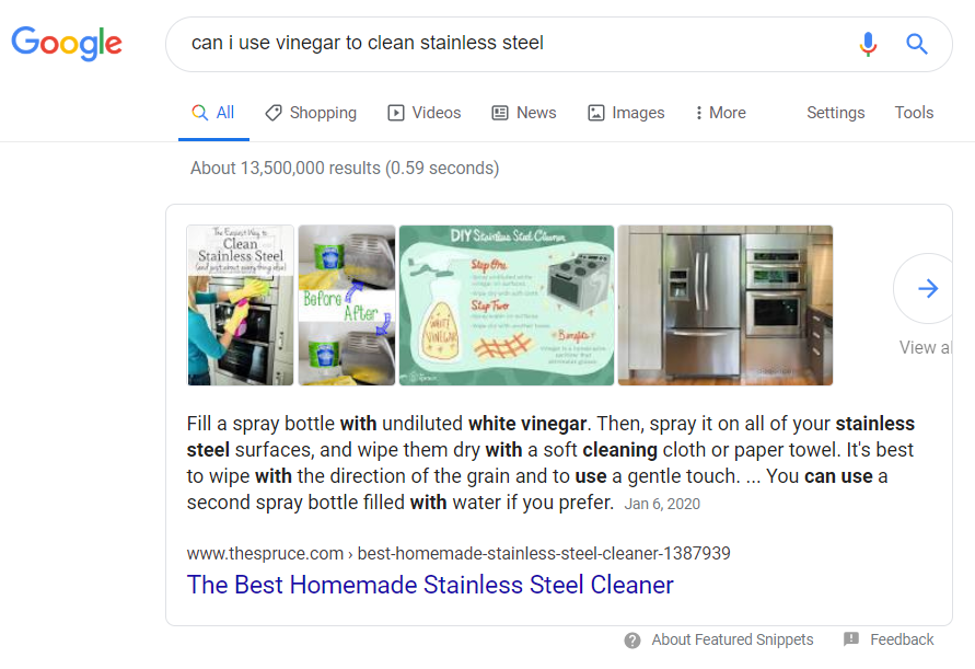
As of October 2019, research showed that 23% of search queries produce a featured snippet.
History of Featured Snippet Updates
The January 2020 Featured Snippet Update and Deduplication
The featured snippet landscape changed in January 2020. Before then, featured snippets were considered the holy grail of search engine optimization. In the SEO community, snippets were referred to as “position 0,” and winning them not only meant your site would show up at the top of Google results, but also that your site could show up twice on page one if it ranked well already.
In January 2020, Google rolled out an update that made it impossible for websites that appeared as the featured snippet to also appear on page one in regular organic search results.
Because of the way Google gathers information about rankings (average position) and impressions (how many times a page appears in search results), most of the metrics in Google Search Console won’t change with the deduplication update.
However, the absence of an organic listing means pages that win the snippet now take up less real estate on page one. In turn, this means they’ll probably get fewer clicks.
June 2020 Update: Auto-Scroll & Highlighted Text
In June 2020, Google updated how featured snippets work again. In short, two things started happening when users click on (some) snippets from search results that didn’t before:
- The user is immediately “jumped” to the relevant text (the text Google displayed in SERPs)
- The relevant text is highlighted in yellow via a URL parameter automatically generated when the snippet URL is clicked
Google also stated that there is no markup needed to generate these two features; it happens automatically via Scroll to Text Fragments.
Here is an example of how the update works. From search results, the snippet might look like this:
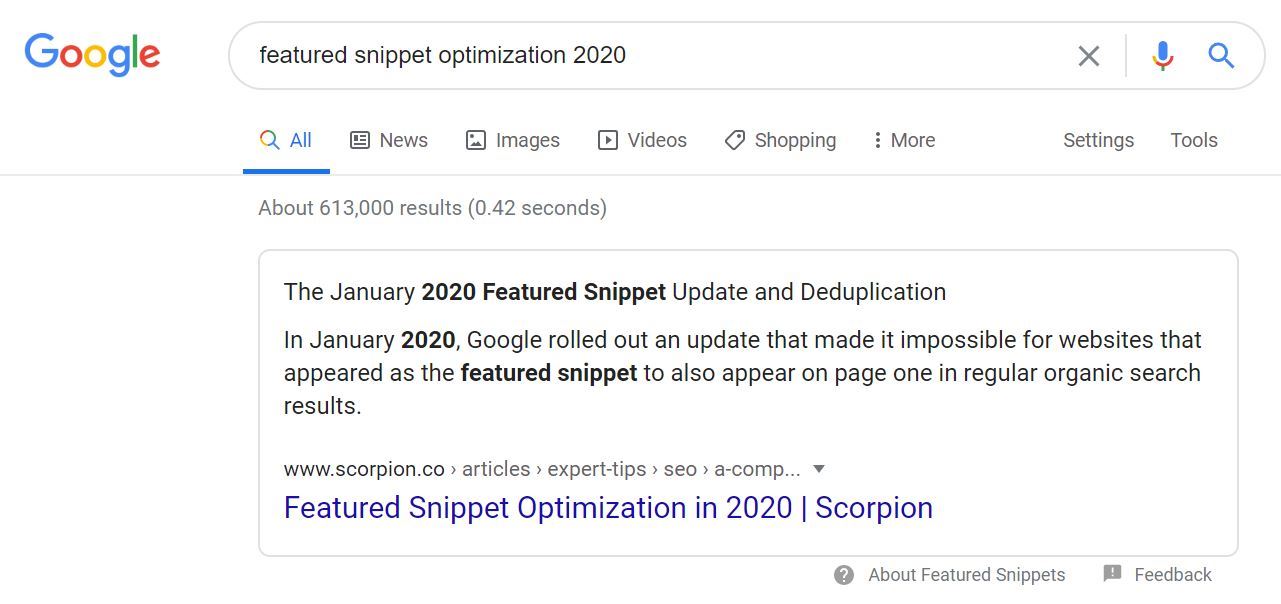 When clicked, users are automatically taken to the relevant text, which is highlighted, like this:
When clicked, users are automatically taken to the relevant text, which is highlighted, like this:
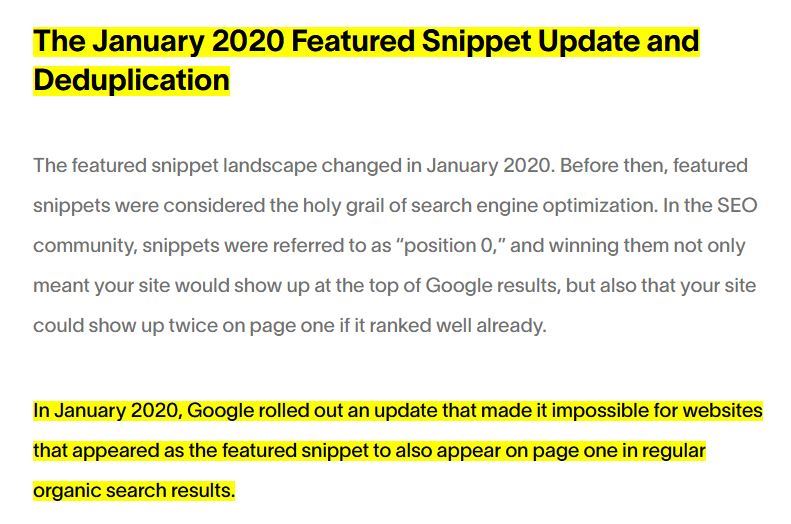
Why Are Featured Snippets Important for SEO in 2021?
Featured snippets are still vitally important for SEO in 2021 for several reasons.
They are closely tied to voice search. Often, pages that earn the featured snippet are also the response for corresponding voice searches. According to Search Engine Land, 80% of Google Home answers are pulled from snippets. Another article (this one from Backlinko) suggests the number of voice search results that pull from featured snippets is closer to 40%.
Brand exposure. At the end of the day, being at the top of page one offers more visibility than anywhere else. Even though snippets tend to have a lower click-to-impression ratio than the rest of organic results, you can’t beat the brand exposure that comes with being on top.
Types of Featured Snippets with Examples
Featured snippets can be categorized into five types: paragraphs, lists, tables, videos, and interactive carousels. Some people have identified accordion featured snippets as well, which function much like Google’s “People Also Ask” box; however, these are rarer.
1) Paragraph Featured Snippets
The most common type of featured snippet is the paragraph. Typically, they are around 50 words long and may highlight or bold certain elements of the text directly related to your search query.
In the example below, the search “is coffee good for you?” produces a paragraph snippet from nytimes.com, in which the words “coffee” and “good” are bold.
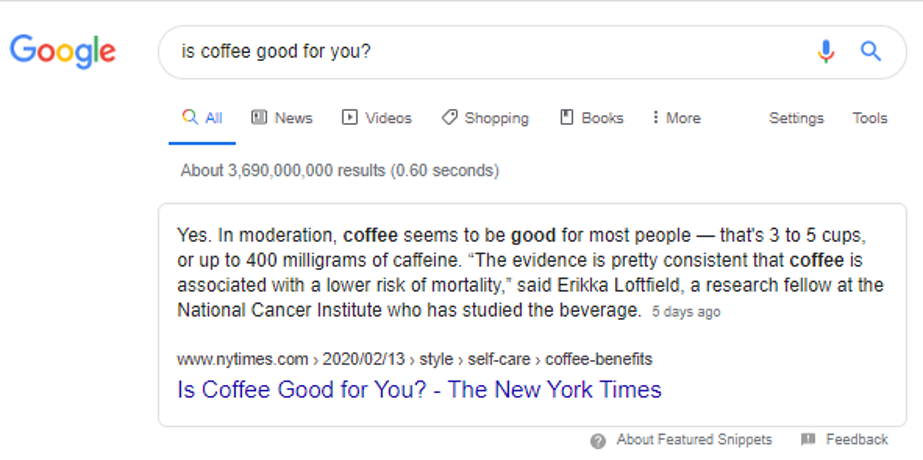
2) Lists
Lists can appear two ways as featured snippets: bulleted and numbered. Often, queries that lead with terms like “best” or “how to” result in list snippets. For “best” queries, lists are likely to populate when the search intent implies the searcher is looking for multiple suggestions, such as “best hairstyles for long hair.”
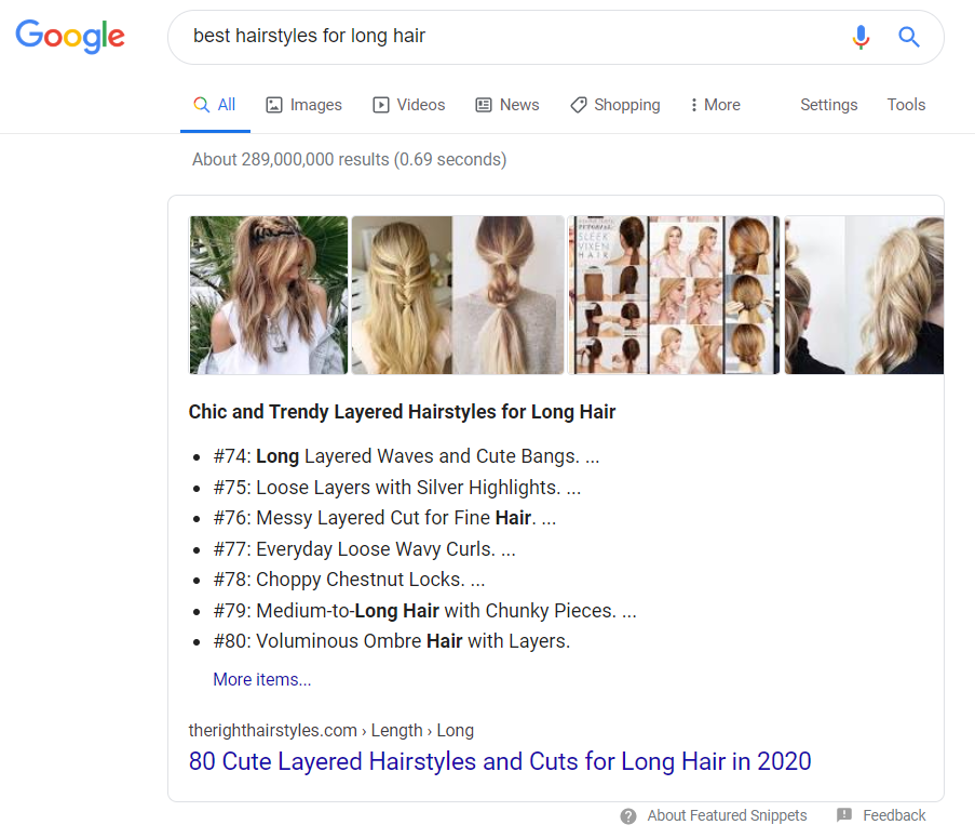
3) Tables
Tables are less common than lists and paragraphs; however, they are a powerful tool for relaying lots of data in a small space. In the example below, the search query “DUI penalties by state” brings up a table with a breakdown of how the penalties for drunk driving differ from state to state. Because there is more information than fits in the featured snippet box, an additional link is provided for users to click through to the website page.
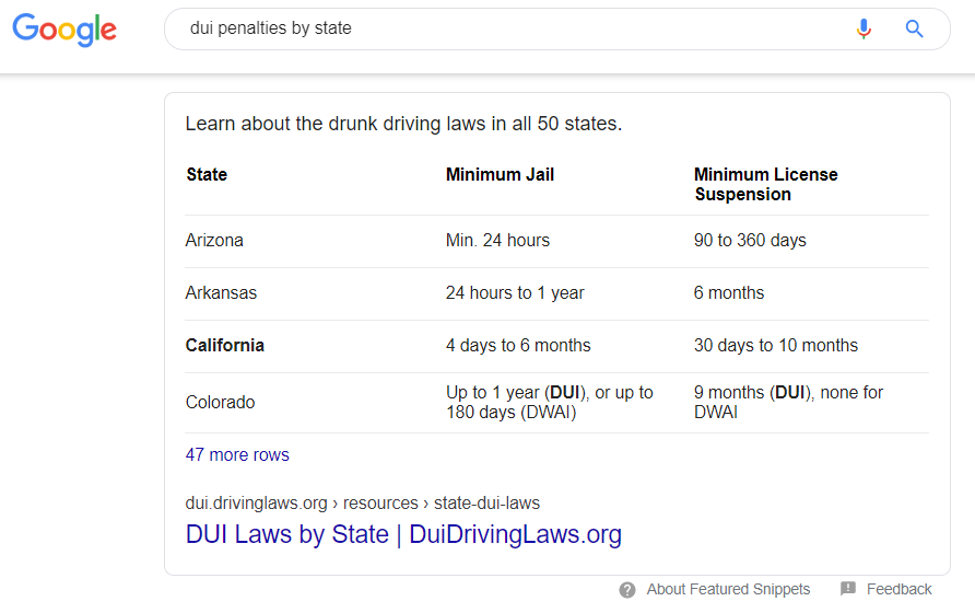
4) Videos
This variety is less common than lists and paragraphs as well, but ultimately useful for answering “how to” queries where users could more easily consume content by watching a video than reading an article.
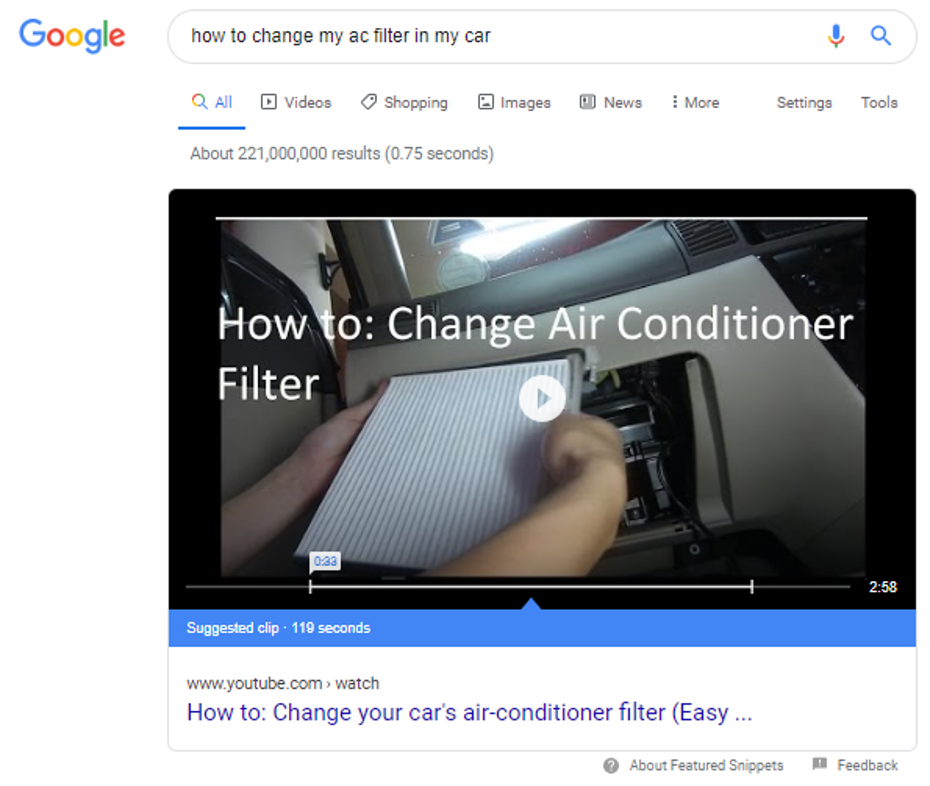
5) Interactive Carousels
One of Google’s most recent additions to the featured snippet family is interactive carousels. These search results provide an immediate answer (such as a paragraph or video), along with the option for users to click through to other, related featured snippets with more specific information.
In the example below, users can navigate the process for changing their name in California and sort the information by driver’s license, birth certificate, etc.
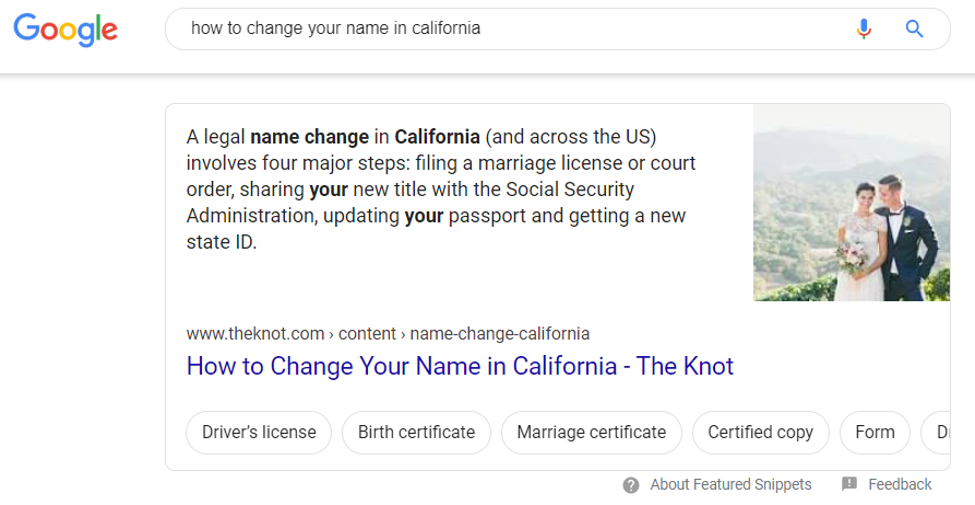
Interactive carousels typically appear combined with another type of snippet, such as a paragraph or video with a carousel underneath.
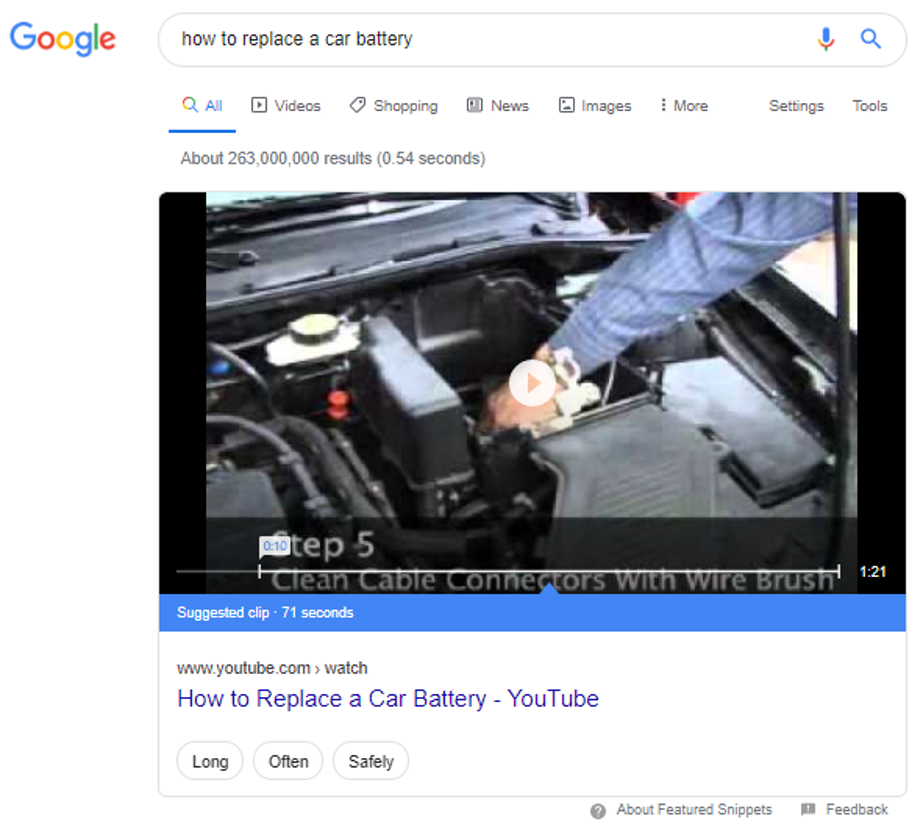
What Isn’t a Featured Snippet
Featured snippets are a specific type of search result, but it’s easy to confuse them with other features on Google. Here are a few items that could be easily confused with featured snippets:
Knowledge Panels
The knowledge panel appears for searches about certain entities (people, places or things). Information within the panel is sourced from many places across the internet and is automatically generated. Individuals and brands that have claimed their knowledge panels, for instance, can also suggest edits to it (although Google does not allow them to edit the information directly without approval).
Unlike featured snippets, knowledge panels do not typically link to a single URL as their source. Instead, clickable elements most often - if not always - take searches to another, related search result page.
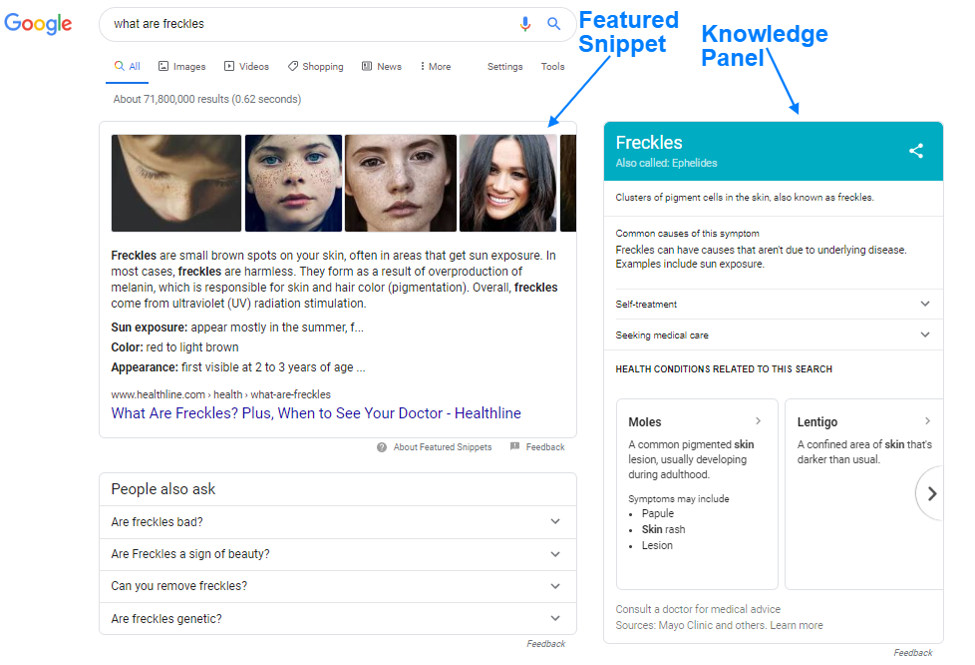
Answer Boxes
Answer boxes appear at the top of search results, just like featured snippets. They look like this:
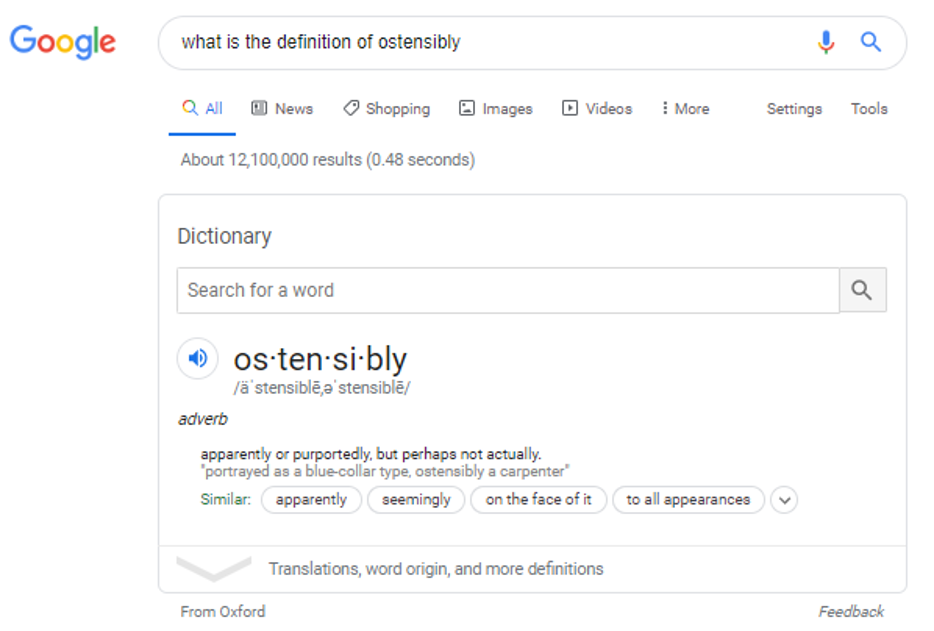
Several indicators help us differentiate between answer boxes and featured snippets. To begin with, Google provides attribution for answer boxes differently than featured snippets. In the example above, you can see the definition of the word “ostensibly” is attributed to Oxford.
In some cases, information isn’t attributed clearly - if at all. Here, we see Wikipedia and Quora.com both discreetly mentioned as sources for the search results “How fast does a cheetah run” - but it’s unclear as to which pieces of information are actually attributed to which source.
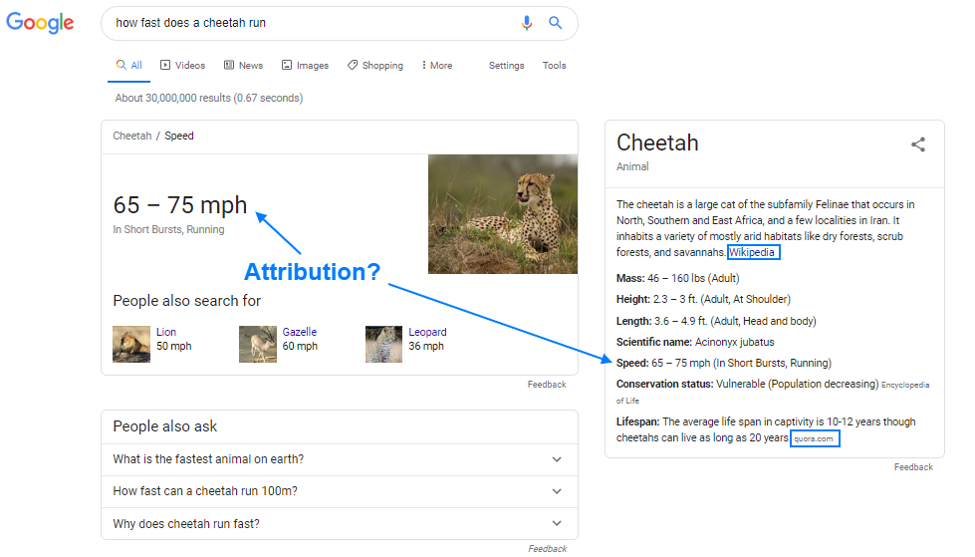
Another interesting indicator is whether or not Google auto-populates the answer to your query before you actually search for it. Often, answer box queries offer a dropdown with Google’s chosen answer before you finish typing.

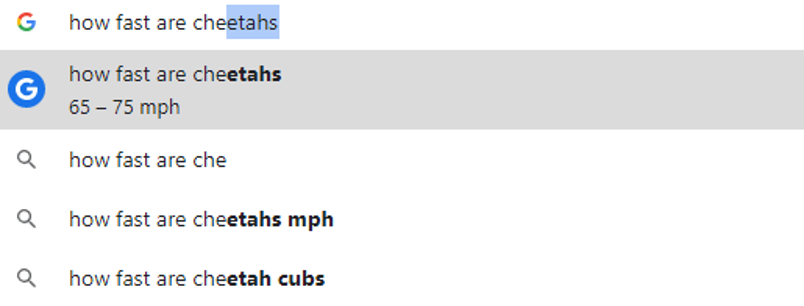
This information is presented differently than the autofill feature, which attempts to guess your query before you’re done typing it based on similar queries from other searchers.
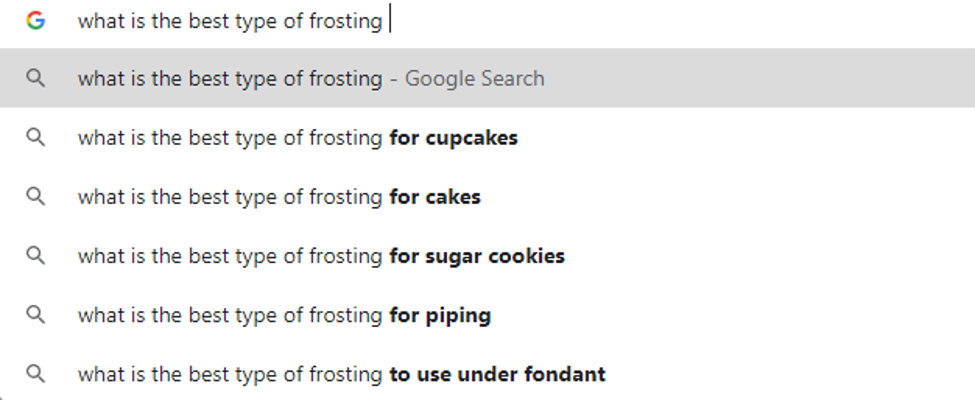
People Also Ask
The “People also ask” box is another common SERP feature that’s easy to confuse with Featured Snippets. That said, “People also ask” is extremely easy to identify because it is always labeled as such, like this:
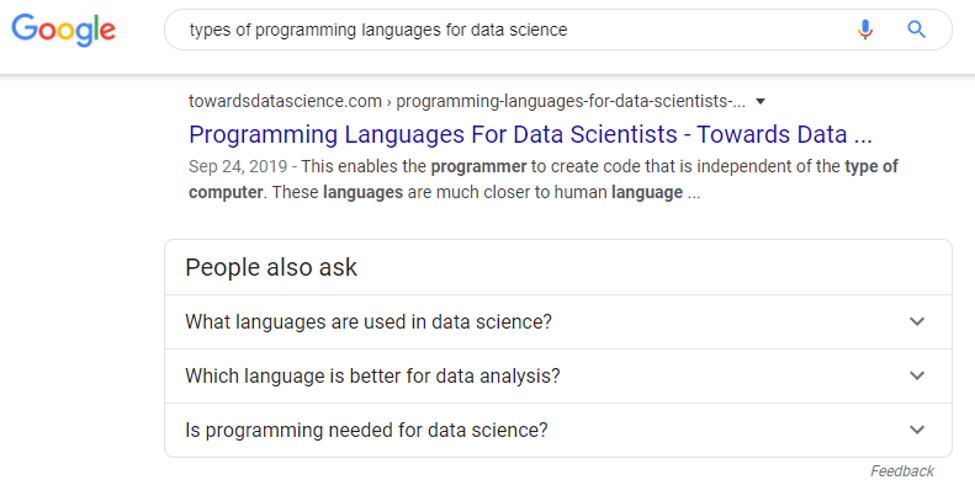
Additionally, it’s not unusual for “People also ask” and a featured snippet to appear for the same result, making it easier to differentiate between the two. When in doubt, simply check the verbiage at the bottom of the SERP feature. If it says “about Featured Snippets,” you’re looking at a featured snippet. If it only says, “feedback,” you’re probably looking at a different SERP feature.
How to find Featured Snippet Opportunities
Featured snippets appear at the top of search results, which means they’re an excellent opportunity to get more visibility for your website. Because of this, winning position one is also very competitive - but that doesn’t mean you don’t have a shot at claiming the snippet throne. Here’s how you can increase your chances of winning the snippet:
Identify queries for which you already rank
Getting on page one is half the battle. Typically, featured snippets are pulled from results on page one (and then de-duplicated once they become the snippet). This means you stand a better chance of earning position one if you already rank on page one for a given search term.
Using SEMRush to Find Featured Snippet Opportunities
Ahrefs and SEMRush both offer great tools to help you uncover snippet opportunities. Enter your domain into SEMrush and navigate to the “Organic Results” report. Then, click on “Positions.”
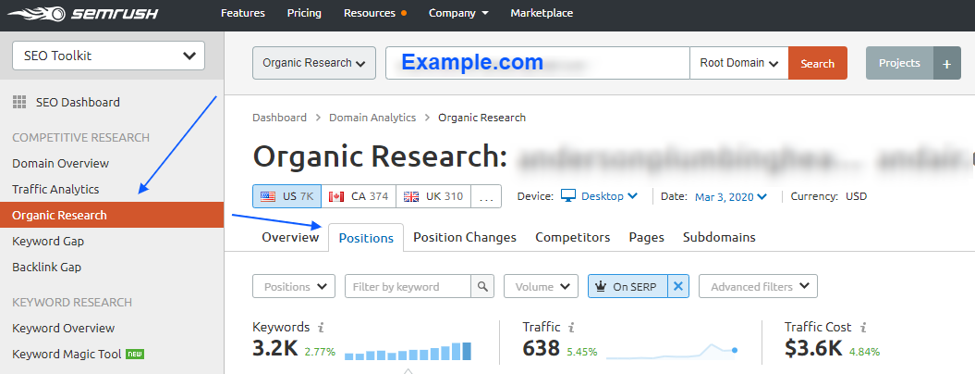
From there, sort the results by Featured Snippets by clicking on the small crown icon in the Search Features column. What you’ll get is a list of search queries for which your site generates impressions (and might rank!) that also have a featured snippet. This report will also tell you if your website is showing up as the snippet result.
Look for queries that already have a snippet, that your site is ranking for, and that have enough search volume to make them worth targeting.
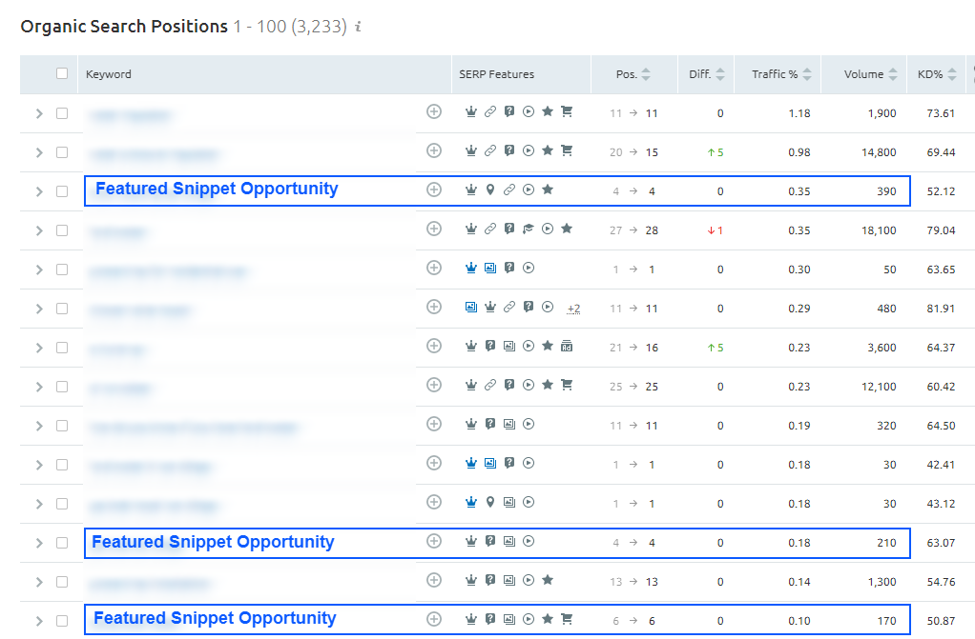
Using Ahrefs to Find Featured Snippet Opportunities
Ahrefs is another great tool for finding featured snippet opportunities and provides data similar to SEMRush. No tool is perfect, which means you’ll probably uncover more opportunities by utilizing multiple resources.
Input your domain in Ahrefs, then navigate to the Organic Search > Organic Keywords report. From there, filter results by SERP Features that include featured snippets, then sort the remaining queries by position. What you’ll get is a list of queries that generate a snippet, sorted by the terms for which your site already ranks pretty well.
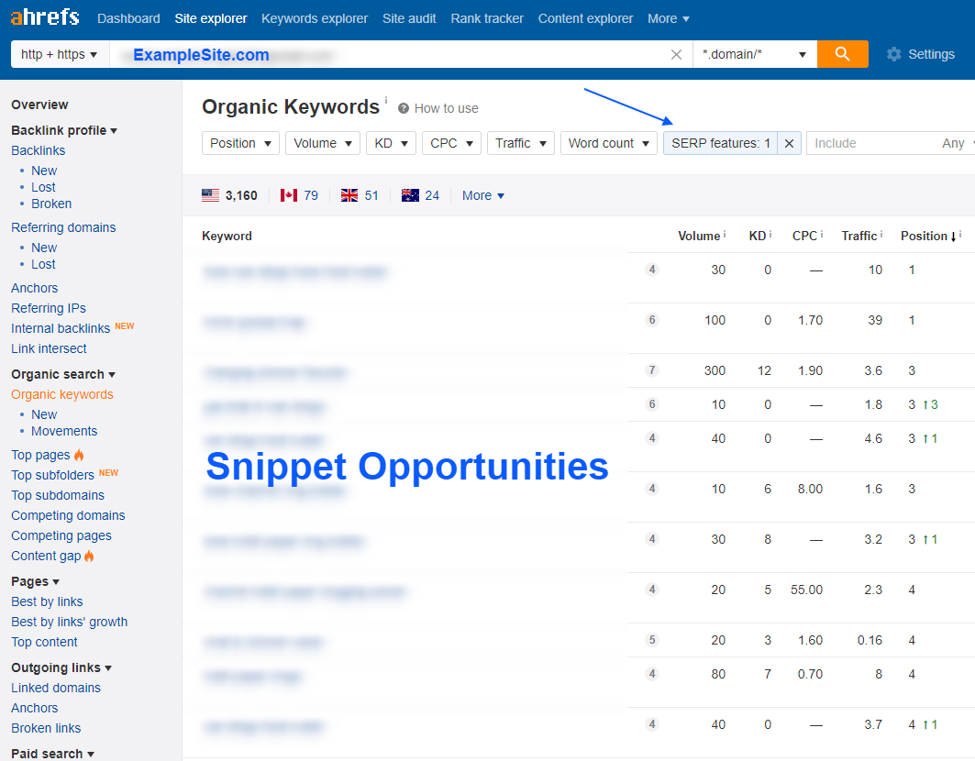
Do your (keyword) research
Search volume will inform your featured snippet targeting - but that doesn’t mean you should always go after terms with the highest number of monthly searches. Depending on the type of website you’re optimizing, it might make more sense to go after terms that are a little less competitive.
Small- or medium-sized businesses, for instance, may want to start by targeting snippets that have a lower search volume but a local intent.
On the other hand, if your site already has national reach, going after terms that are generating the most interest may be the smarter play.
What if I don’t have any featured snippet opportunities?
If your site doesn’t rank well enough for any snippet-worthy terms, focus on improving your website content and getting on page one. There are a few ways to do this, but two of the simplest are:
- Create new content
- Update existing content
Whether you’re building out new pages or improving what’s already on your site, your goal should be to give searchers what they’re looking for and generate content for users, not algorithms. Coming up with SEO content ideas in 2021 is much simpler when you focus on building out your site for users instead of just Google.
Also, keep in mind that Featured Snippets aren’t just for sites with a national or international reach; small businesses can target snippets, too! If your site hasn’t built up enough traction to gain any page-one rankings for “snippeted” search results, focus on finding terms that produce results unique to your location or terms related to a niche service or product you provide.
Even if these types of queries don’t get the same volume as other, more competitive searches, you stand a better chance of earning position one if the results are less saturated with content addressing those users’ needs.
On-Page Optimization Best Practices for Featured Snippets in 2021
At the end of the day, best practices for featured snippet optimization are essentially the same as any other SEO project: Give users what they need in the most accurate and informative way possible. That said, there are a few things you can do to better optimize your content for position one in 2021.
1) Use Images (unless you want someone else to claim the thumbnail).
Many featured snippets are accompanied by an image thumbnail; however, Google doesn’t always decide to use the image from the source page for the snippet. This means you’ll want to provide a relevant image and optimize it accordingly. Make sure the image file name is relevant and the image itself is identifiable through its alt-text attributes.
2) Satisfy the search query within 50(ish) words.
Paragraph featured snippets tend to include roughly 50 words of text. This means you’ll want to provide the information users need in less than 50 words. Technically, there is some flexibility on the length of featured snippets; however, 50 words is a good target.
3) Focus on the primary question throughout the page.
According to Google, featured snippets are especially likely to show up for question-based searches. When you’re optimizing a page for a given query, focus on answering the question or questions related to that topic throughout the entire page. Even if the query itself doesn’t end in a question mark, your content should still answer the “question” behind it.
Consider the query, “best cat food for kittens.” While this isn’t a question, grammatically speaking, the search intent is probably akin to “What is the best cat food for kittens?” In other words, there is still a question or query to satisfy even if the search is not framed as a question.
4) Think like a journalist and use the inverted pyramid
The inverted pyramid is a technique used by journalists that describes how an ideal news story should be structured. In short, articles should open with the most important - or most “newsworthy” information at the top; the first sentence should be the most interesting.
As the article progresses, the information should become less newsworthy until all of the information related to the story is shared.
When optimizing a page (or section of a page) for a featured snippet, keep the inverted pyramid in mind. Start with the most important information in the first sentence, then include the second-most important information in the second sentence, and so on.
Provide the answer to the question first, then the context. Once complete, you should be able to remove content from the bottom of the page / section and still find the answer to the query because it was prioritized at the top of the page.
5) Answer semantically related questions, too.
Some pages rank for more than one featured snippet. If a page ranks for ten or more, it’s called a “featured snippet hub.” Often, these questions are semantically or topically related to each other. When targeting even one featured snippet, provide information within the page that answers other questions that may be relevant to users searching for your “target” query.
The “People also ask” box is a great place to find these types of questions.
6) Utilize headings to target specific questions.
Updating your sub-headers to directly ask the question your content will answer is a simple way to help users and search engines understand what the page is about. The same goes for unique sections of your page designed to answer specific questions. If updating your header to an exact-match version of the question you want to target makes logical sense, do it.
7) Format your content for specific featured snippet types.
Different featured snippet types lend themselves to answering different types of queries. Lists, for instance, might be the best way to answer certain types of “how-to” searches. Some snippet types are suited to more information-heavy results, such as a table:
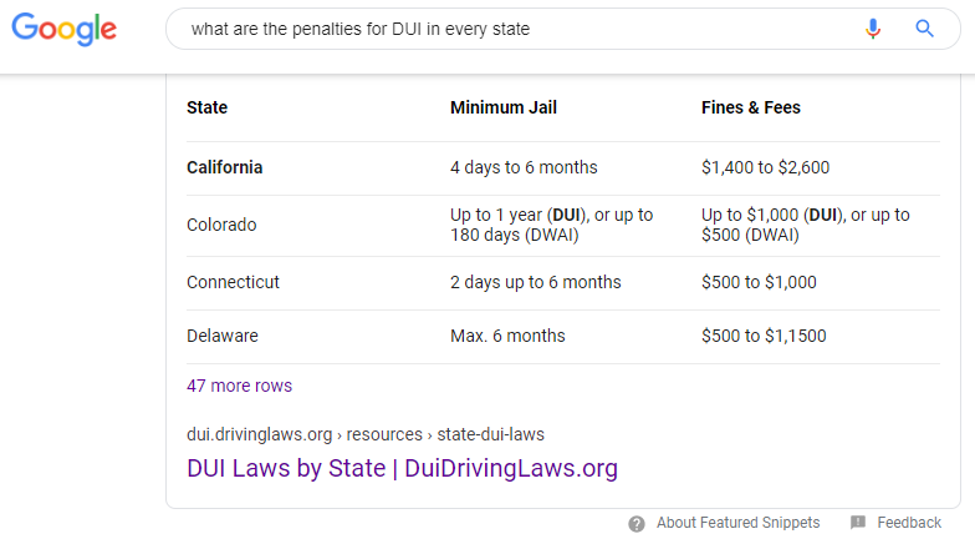
Take this into consideration when optimizing your page for a featured snippet. If the query merits a list, use bullets or a numbered list to answer the question. If a paragraph will suffice, use that instead.
8) Provide value competitors don’t have.
Make sure your content provides value competitors don’t, otherwise there’s no logical reason for Google to favor your result over other sites. If your goal is to push another site out of the snippet and claim it for yourself, you need to offer something other websites are not.
Obviously, there are many, many factors that contribute to your website’s placement in SERPs, but providing value users can’t get from other sources is one way to make your page stand out from the crowd.
9) Don’t give up if you don’t earn the snippet the first time!
Getting the featured snippet can be exciting - but don’t be discouraged if you optimize your site and don’t win. Keep trying. Featured snippets are notoriously volatile, so don’t be afraid to keep refining your content and trying new techniques. Just make sure you’re giving Google enough time to view and re-index the page between edits.




